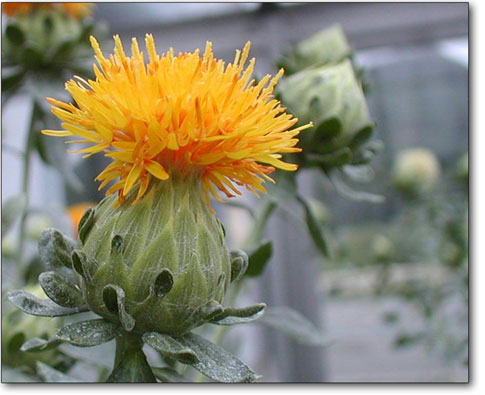| ||
Safflower in your tank
by Chef Boy Ari Beneath his mild-mannered exterior, there is a passionate side to Paul Miller. As the conversation turns inevitably to Paul’s quest to convert vegetable oil into diesel fuel, his eyes flash. It’s a simple process, if you’re a chemist, and Paul and his partners have become adept at it. But because they don’t have the production capacity to produce biodiesel as cheaply as they can buy it on the open market, economics dictate that their company, Sustainable Systems, satisfy America’s growing demand for biodiesel by re-selling purchased biodiesel. “The plan,” says Paul, “was to create a market for biodiesel while we figured out a way to produce enough of it, cost effectively, to satisfy the demand we created.” Biodiesel’s potential is enticing. Rather than depending on drilling and mining for our fuel, farmers can grow oilseed plants using equipment powered by biodiesel and deliver it to market in biodiesel-powered vehicles, which produce fewer emissions than petroleum-derived diesel. Over coffee last week, he tells me he is one step closer to this goal. Sustainable Systems recently purchased Montola, a safflower oil company based in Culbertson, Mont. With the company comes its large processing plant and a network of oilseed growers. “We got a dedicated and experienced group of people who are committed to working toward a new vision,” says Paul. The vision is to unite urban consumers and rural producers in vegetable oil-based harmony. Sustainable Systems will continue making safflower oil while expanding the contracted acreage of oilseed under cultivation and eventually produce a lot of biodiesel. Paul scribbles on a napkin as he describes his plan to turn eastern Montana into a well of eco-fuel. “We want to produce 15 million gallons of biodiesel, which requires 15 million gallons of oil, which takes about 250,000 acres to grow. The amount of locally contracted acres supporting those 15 million gallons is going to be less than 10 percent the first year. The difference will be made up by purchased vegetable oil. The following year, 20 percent will be grown locally. With each year, more oil is produced locally and less will be purchased.” Paul is also considering producing other kinds of edible oils, such as canola. But while diversity is good, he’s reluctant to go there because he believes safflower oil to be vastly superior to canola. I agree. Since trying Montola safflower, it’s been the oil I most often reach for in the kitchen. Its high oleic acid content makes it great for high-heat applications like frying. And its pleasant, mellow flavor makes it good in sauces, marinades and mayonnaise. Whatever you need your oil to do, Montola gits ’r done. Tom Siegel, executive chef at the University of Montana’s Dining Services, likes it too. “We did a side-by-side test of Montola verses Fry-On, the brand of hydrogenated soy oil we used to use. Fry-On is cheaper at the front end, but our tests revealed that Montola was absorbed less than Fry-On. It also had a longer life in the fryer. These two factors, plus the fact that it is a local product, and more healthy than Fry-On, made it a win-win situation to switch. It’s great that the little Montola company beat out the behemoth national brand, and that Sysco, our main supplier, responded and agreed to carry it for us.” And Montola does more than fry. “We did a taste comparison with our other salad oils,” Siegel continues. “Montola was lighter on the palate and worked fine for emulsions, griddling, grilling, coating and oven-roasting veggies. Of course we do a lot of frying, but we also do a lot of sautéing. Montola has a light, neutral flavor that showcases the flavor of the product.” Siegel gave me a recipe for braised artichoke that calls for Montola safflower. After butchering the recipe, and an artichoke, in the test kitchen, I took a different tack, more in the spirit of local food, and did some research on winter stir-fry. Stir-fry is a good application of Montola, because the ingredients are fried quickly in high heat. I thawed some Alaskan salmon and put it in a marinade of soy sauce, sugar and rice vinegar. While frozen kale and broccoli from the garden thawed, I cut carrots into thin spears and fried them hot in the wok in Montola oil. I post-holed through the snowy garden and found some Brussels sprouts clinging to the stalk, and fried them too. After frying each item, I kept them warm in the oven. Then I added slices of ginger to the hot oil and, when they were cooked, chopped shallots. To that I added broccoli and mashed garlic, stirring quickly for 15 seconds before adding the marinade from the salmon and stirring it together with the veggies from the oven. The fish, meanwhile, was on the grill, to be served over stir-fried veggies atop a bed of rice. I toasted the high-frying antics and lofty goals of Paul Miller and his oilseed empire. Then I ate my stir-fry. •
|


